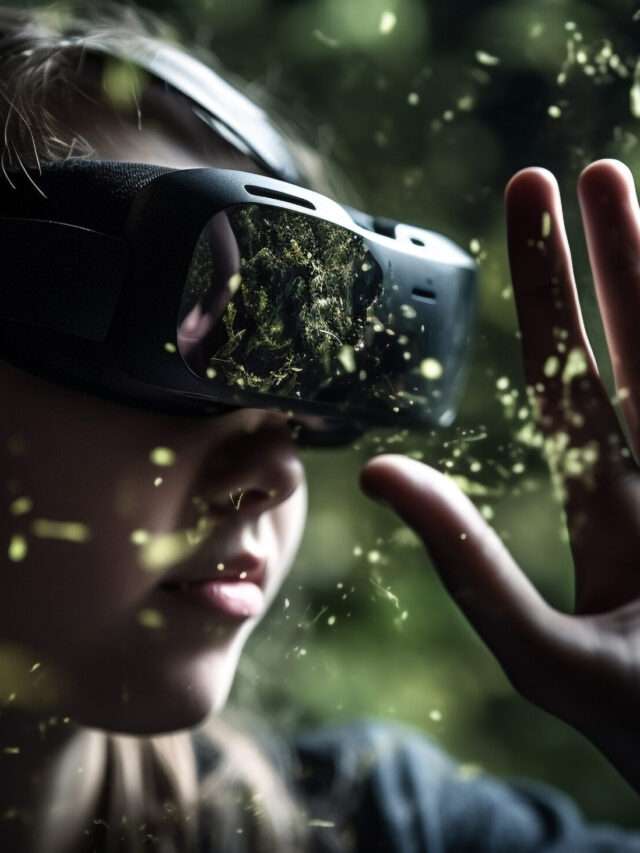The integration of AR (Augmented Reality) and VR (Virtual Reality) in schools is not just about enhancing traditional teaching methods; it signifies a profound transformation in education. These technologies empower students to learn actively, explore complex concepts, and prepare for the future workforce.
Moreover, AR and VR in schools will foster global collaboration, address educational inequities, and open doors to innovative teaching methods and research opportunities. Embracing AR and VR in school education is not merely a technological trend but a strategic investment in the next generation’s learning and future success.

Why AR and VR in Schools?
Implementing AR and VR in schools is of paramount importance for several compelling reasons:
1. Engagement and Motivation
AR and VR in schools make learning more engaging and enjoyable. Interactive 3D simulations, virtual field trips, and hands-on experiences captivate students’ attention and spark their curiosity. This heightened engagement translates into increased motivation to learn and explore.
2. Enhanced Understanding
Complex and abstract concepts in subjects like science, mathematics, and history can be challenging to grasp through traditional teaching methods. AR and VR in schools provide visual and interactive representations that make these concepts more tangible and easier to understand, leading to improved retention and comprehension.
3. Experiential Learning
AR and VR in schools enable experiential learning, allowing students to “visit” historical sites, conduct virtual experiments, or explore outer space. These immersive experiences provide a deeper level of understanding that goes beyond reading textbooks or watching videos.
4. Accessibility and Inclusivity
AR and VR in schools technologies can accommodate various learning styles and cater to students with different needs. Visual, auditory, and kinesthetic learners can all benefit from these experiences. Additionally, AR tools can provide real-time assistance for students with special needs.
5. Safe Exploration
In subjects like chemistry or biology, conducting experiments in a real laboratory can be hazardous and costly. Virtual labs in VR offer a safe and risk-free environment for students to experiment freely. Mistakes are part of the learning process, and VR allows students to make them without consequences.
6. Global Learning
Virtual classrooms and AR-enabled language exchange programs connect students with peers and educators worldwide, fostering cultural understanding and global perspectives. Students can collaborate on projects, share experiences, and gain insights from different cultures.
7. Personalized Learning
AR and VR technologies can adapt content to individual learning paces and preferences. This personalization ensures that students receive tailored educational experiences, helping them reach their full potential.
8. Preparation for the Future
As technology continues to play a significant role in the workplace, students who are familiar with AR and VR gain skills that are increasingly relevant in various industries. Early exposure to these technologies better prepares them for future career opportunities.
9. Data-Driven Education
AR and VR platforms collect valuable data on students’ progress and interactions. Teachers can use this data to identify areas where students may be struggling and adjust their teaching methods accordingly, ensuring a more effective and targeted educational approach via AR and VR in schools.
10. Teacher Professional Development
AR and VR in schools can also benefit educators. They can use these technologies for their professional development, attending virtual conferences, learning about new teaching methods, and collaborating with colleagues worldwide.
11. Cost Savings
While there may be initial costs associated with implementing AR and VR in schools, these technologies can lead to long-term cost savings. Virtual labs reduce the need for expensive laboratory equipment, and virtual field trips eliminate travel expenses.
Utilization of AR and VR in Schools

Here is a list of areas in schools where augmented reality (AR) and virtual reality (VR) are successfully implemented:
- Science Education: AR and VR in schools enhance biology, chemistry, and physics lessons by providing interactive 3D models, simulations, and virtual experiments.
- History and Social Studies: Virtual field trips, historical reenactments, and immersive experiences transport students to different time periods and cultures.
- Language Learning: VR immerses students in foreign language environments for realistic conversational practice and language acquisition.
- Mathematics: Complex mathematical concepts are visualized and explained through AR and VR simulations, making them more accessible to students.
- Geography: Virtual globes and geographical simulations allow students to explore the world’s geography and ecosystems.
- Art and Creativity: VR art studios enable students to create digital artwork and explore artistic techniques in a virtual space.
- Special Education: AR and VR in schools provide tailored learning experiences for students with special needs, helping them engage with the curriculum.
- Career Education: Students can explore various career paths through virtual job shadowing and industry-specific simulations.
- Physical Education: VR sports simulations and AR fitness apps encourage physical activity while enhancing sports knowledge and skills.
- Environmental Education: VR simulations of ecosystems and wildlife provide environmental education and awareness.
- Cultural and Language Exchange: VR connects students with peers from other countries for cultural exchange and language learning.
- Health and Safety Training: VR scenarios prepare students for emergencies, fire drills, and safety procedures.
- Libraries and Research: AR & VR in schools enhances library resources with interactive content and virtual book displays.
- Music Education: VR music studios offer immersive music composition and performance experiences.
- Museum and Artifact Exploration: Virtual museum tours and artifact examinations bring history and culture to life.
- Virtual Reality Storytelling: Students can create and experience their own immersive stories and narratives using VR technology.
- Extracurricular Activities: AR and VR in schools are used in clubs and extracurricular programs, such as robotics, gaming, and coding clubs.
- Professional Development: Teachers and educators use VR for professional development, training, and collaboration.
- Student Presentations: AR and VR presentations enhance student projects, reports, and public speaking engagements.
- Psychology and Social Sciences: VR simulations allow students to explore psychological concepts, social scenarios, and behavioral studies.
Examples of AR and VR in schools

1. Interactive Science Lessons
- Imagine a high school biology class learning about the human anatomy. Traditionally, students would study diagrams in textbooks or watch static PowerPoint presentations.
AR Application:
- AR Anatomy Models: Students are provided with AR-enabled tablets or smartphones. By pointing their devices at images in their textbooks or posters on the classroom wall, 3D models of the human body appear on their screens.
- Interactive Exploration: Students can rotate, zoom in, and dissect the virtual body models on their devices. They can tap on different organs to access information pop-ups, watch animations, or hear audio explanations.
- Quizzes and Assessment: The AR app can also include interactive quizzes that test students’ knowledge in real-time. Teachers can track individual progress and provide immediate feedback.
Benefits:
- Engagement is significantly improved as students interact with the subject matter.
- Visual and kinesthetic learners benefit from the 3D models.
- Immediate feedback and assessments aid in gauging understanding.
2. Historical Field Trips
- Taking students on field trips to historical sites may not always be feasible due to budget constraints or distance.
AR Application:
- Virtual Field Trips: Using AR headsets, students can embark on virtual field trips to historical sites, such as the Pyramids of Egypt or the Great Wall of China.
- Immersive Exploration: In the virtual environment, students can explore these sites as if they were physically present. They can interact with historical artifacts, watch re-enactments, and even engage in guided tours with historical figures.
- Historical Research: After the virtual trip, students can use AR to access additional historical information, timelines, and primary sources related to the visited site.
Benefits:
- AR field trips provide access to places students may never have the opportunity to visit.
- The immersive experience fosters a deeper understanding of history.
- Students can conduct research and explore historical contexts independently.
3. Immersive Language Learning
In a language class, students are learning to speak Spanish. Traditional methods involve reading textbooks and listening to audio tapes.
VR Application:
- Virtual Language Immersion: Students put on VR headsets and find themselves in a virtual Spanish-speaking environment, such as a bustling market in Madrid.
- Conversational Practice: They interact with virtual characters who engage them in Spanish conversations. The VR environment encourages them to use the language to navigate daily scenarios.
- Real-Life Application: Students can order food at a virtual café, ask for directions, or negotiate prices at the virtual market—all while speaking in Spanish.
Benefits:
- Immersive VR environments provide a realistic language learning experience.
- Students gain confidence in using the language in practical situations.
- Pronunciation and fluency improve through repeated interactions.
4. AR-Enhanced Chemistry Textbooks:
In addition to VR, the classroom employs AR to supplement traditional learnings
- Interactive Textbooks: Students have AR-enabled chemistry textbooks. By scanning pages with their smartphones or tablets, 3D models of molecules and chemical reactions appear, allowing students to interact with complex concepts.
- Augmented Explanations: When studying a chemical reaction in their textbooks, students can point their devices at diagrams to see animations of the reaction mechanisms and access additional explanations. They can also access video demonstrations of experiments.
Benefits:
- Students receive a dynamic and immersive learning experience that bridges the gap between theory and practice.
- Complex chemical concepts become tangible and easier to understand.
- Safety concerns associated with traditional labs are eliminated, making chemistry more accessible to all students.
- Teachers can track individual progress, and students have opportunities for independent experimentation and exploration.
- Students graduate with a deep understanding of chemistry principles and hands-on experience, better preparing them for further education or careers in the sciences.
AR and VR in schools are transforming education by providing immersive and interactive learning experiences. These technologies cater to different learning styles, engage students in subjects that may have previously seemed abstract or distant, and encourage independent exploration and critical thinking.
Conclusion
The integration of AR and VR in schools represents a monumental shift in education. It goes beyond the adoption of technology; it’s a commitment to providing students with the tools and experiences they need to thrive in a digital age. AR and VR make learning exciting, accessible, and relevant, preparing students not just for exams but for a future where technology plays a central role. It’s a journey towards a more engaging, inclusive, and effective educational landscape.
FAQs
1. Are AR and VR expensive to implement in schools?
While there may be initial costs, the long-term benefits, including reduced equipment expenses and enhanced learning outcomes, often outweigh the initial investment.
2. How do AR and VR benefit students with special needs?
AR and VR can be tailored to accommodate various learning styles and provide real-time assistance for students with special needs, making education more inclusive.
3. Are there any safety concerns with AR and VR in schools?
AR and VR provide a safe environment for experiments and simulations, eliminating many physical hazards associated with traditional labs.
4. Can AR and VR replace traditional teaching methods entirely?
AR and VR are powerful supplements to traditional teaching methods, enhancing engagement and understanding but not necessarily replacing them entirely.
5. What skills do students gain from using AR and VR in education?
Students develop skills such as critical thinking, problem-solving, and familiarity with technology, which are highly relevant in today’s workforce.

Your article helped me a lot, is there any more related content? Thanks!
Your article helped me a lot, is there any more related content? Thanks!